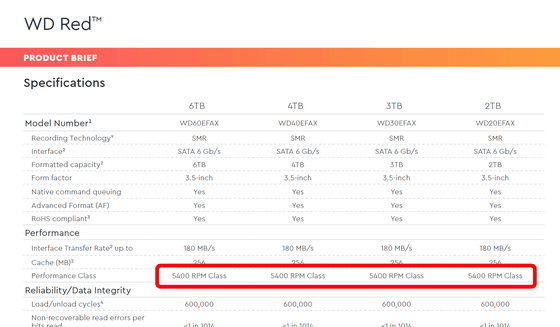It turns out that the rotational speed of some Western Digital HDDs differs from the nominal specifications

There are two main types of hard disk drive (HDD) rotation speeds: 5400 rpm (revolutions per minute) and 7200 rpm. Since the data transfer speed and power consumption change depending on the number of rotations, the number of rotations is an important factor in measuring HDD performance. With the HDD of American storage maker
WD Elements and My Book 8TB appear to be 7200rpm, despite reporting as 5400rpm: DataHoarder
https://www.reddit.com/r/DataHoarder/comments/gy3lvw/wd_elements_and_my_book_8tb_appear_to_be_7200rpm/
Western Digital is trying to redefine the word “RPM” | Ars Technica
https://arstechnica.com/gadgets/2020/09/western-digital-is-trying-to-redefine-the-word-rpm/
It has been pointed out that the actual number of revolutions may differ from the number of revolutions on the specifications for Western Digital HDDs. In order to verify this, Reddit user Amaroko investigated how many revolutions the WD80EMAZ-00WJTA0 and WD80EZAZ-11TDBA0, which are helium-filled type , among the HDDs of the nominal '5400 rpm class' are actually.
To check the rotation speed of the HDD, Mr. Amaroko placed the actually activated HDD on a cardboard box and recorded the sound of the HDD with a microphone. Then, when the sound of the recorded HDD was analyzed by Adobe Audition , it was found that the fundamental frequency of both HDDs was 120Hz. This means that the sound that sounds from the HDD is composed of sounds with frequencies of 120Hz, or 240Hz, 360Hz, 480Hz and their integral multiples.
The following image shows the result of actual spectrum analysis of WD80EMAZ-00WJTA0.

The spectrum analysis result of WD80EZAZ-11TDBA0 looks like this.

The basic frequency of the sound produced by the HDD is 120Hz, which means that the HDD is rotating 120 times per second. Since 120 revolutions per second x 60 = 7200 rpm, it turns out that the rotation speed of at least the two HDDs that Amaroko verified is 7200 rpm instead of 5400 rpm.
At first glance, the difference in the number of revolutions does not seem to be a big problem, but as the number of revolutions increases, the
The specification table of WD Red published by Western Digital has a very ambiguous notation of '5400 rpm class '. If this 5400 rpm class is not the actual number of revolutions, it is unknown what it is pointing to, and there is no footnote in the spec table.

Ars Technica asked Western Digital about this '5400 rpm class,' a Western Digital spokesperson said, 'Western Digital is a specific product, rather than revealing the number of revolutions, it is a 'class' or a 'performance class'. As with all Western Digital products, our product details (data rates) have been tested to meet the specifications in the product datasheets and marketing materials. I will answer.'

In response to this response, Ars Technica commented, 'Western Digital is trying to redefine the unit'rpm'.' 'Western Digital's answer is of no use, and in the end there is no definition of what the 'rpm class' is,' he said.
Related Posts:
in Hardware, Posted by log1i_yk







